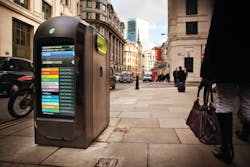IED mitigation strategies and technology
If there’s one thing Monday’s Boston Marathon bombing has reinforced among Americans, it is that Improvised Explosive Devices (IEDs) are no longer limited to war zones and other faraway locales — IEDs are a legitimate security threat that must be mitigated by law enforcement to the best of its ability. Due to experiences on the battlefield, government and law enforcement officials, and vendors have the technologies and strategies to do so; however, much more can be done in the name of homeland security to diminish the risk.
“IEDs cannot be stopped — they can only be mitigated and managed,” explains Grant Haber, a security consultant and vice president of American Innovations Inc., a supplier of bomb mitigation technology and training services. “That needs to start with more interdiction and training geared around the homemade explosive precursors. If you take away the raw materials, it makes it that much harder for the bad guys to make their bombs, and then the size of those bombs will get smaller.”
A concerted effort to limit the amount and availability of the materials, along with a few strategies for the use of technology such as blast-mitigating trash receptacles and explosives detection, can go a long way toward making public gatherings less of an enticing target for domestic terror.
The IED Threat
According to Haber, the majority of all homemade bombs contain ammonium nitrate-based fertilizer or potassium chlorate. It has been speculated that the bombs that were detonated in Boston were made with black powder, which contains potassium nitrate. In Afghanistan for example, more than 90 percent of IEDs use homemade explosive with either nitrates or potassium chlorate, what Haber calls “homemade explosive precursors.”
“Ammonium nitrate, potassium chlorate and variations of other nitrates and chlorates used as a homemade explosive precursor are non-volatile chemicals, unlike peroxide-based explosives that are very dangerous to manufacture or transport in large amounts,” Haber explains. “This is why it’s the weapon of choice — it’s inexpensive, it’s easy to get, it’s easy to convert into HME (homemade explosives), and it delivers a very powerful punch.”
To mitigate the threat of IEDs, law enforcement agencies can use an explosives field detection kit to analyze unknown bulk materials for nitrates or chlorates; or, use an explosives trace detector to determine if actual explosives residue is present. Trace detection devices are made by a variety of security industry vendors and do not require extensive operator training, which is why they are popular with agencies tasked with protecting the homeland, such as the TSA. American Innovations' XD-2i trace detector is popular among first responders and civilian bomb squads.
Bulk detection involves testing a particular substance to detect nitrates and/or chlorates. A typical bulk detection kit contains some way to take a small sample and test it — much like a law enforcement narcotics testing kit. Trace detection involves swabbing surfaces — such as hands, bags, tabletops, etc. — to find miniscule amounts of a variety of explosives. Anyone who has had their bag flagged for additional screening at the airport has seen a trace detection system at work.
A more proactive way to mitigate the IED threat, according to Haber, will require some work at the legislative level. He points to Afghanistan, where in 2010, President Hamid Karzai completely banned all fertilizers that contained ammonium nitrate — coincidentally, the same substance that was used in the 1995 bombing of the Alfred P. Murrah Federal Building in downtown Oklahoma City. “We need to start aggressively monitoring and banning these homemade explosive precursors that we know with 100-percent certainty are being used to manufacture homemade explosives and, in turn, become the main charge in an IED,” Haber says. “We need to get our elected officials involved — they talk about gun control and immigration, but IEDs are not on their priority list.
“We can never totally stop IEDs, but if we can effectively choke the flow of the precursors, the IED events will obviously start spacing out,” Haber continues. “There are plenty of fertilizers out there that cannot be converted into explosives. If we can equip and train law enforcement on what homemade explosives precursors are, and focus on how to identify and detect them, and how to differentiate them from legal fertilizers and other bulk materials not used to make explosives, that is going to attack the heart of the IED problem.”
Blast-Resistant Receptacles
It has been widely reported that the Boston bombs were planted in trash receptacles near the end of the heavily-populated marathon route. The IEDs were placed inside the receptacles — first because they provide concealment, and second, so when the explosion occurs, it creates wide areas of shrapnel that cause massive damage. While the only 100-percent-effective method to ensure that these receptacles are not used in this way is to completely eliminate them from the area, there are a variety of vendors who produce blast-resistant trash receptacles to mitigate the shrapnel and concealment risk.
ASTM International, formerly known as the American Society for Testing and Materials (ASTM), explains these receptacles in detail in its E2831 / E2831M - 11 Standard Guide for Deployment of Blast Resistant Trash Receptacles in Crowded Places, available at www.astm.org/Standards/E2831.htm. According to ASTM, two major effects resulting from an explosion in a trash receptacle are the production of primary and secondary fragments, and overpressure from the detonation. Another effect is the fireball, which may cause burns or ignite other combustible material in the area.
“The deployment of blast-resistant trash receptacles provides a means for decreasing injury and lethality during an explosive event, no matter their location, when compared to the protection afforded by ordinary trash receptacles or clear plastic bags,” ASTM reports. The receptacles cannot completely contain an explosion; however, they are designed with hardened materials to capture fragmentation of the receptacle, thus limiting the amount of shrapnel — and ideally damage — that is produced by an explosion within one. Each vendor’s receptacle is limited in the amount of explosives it can contain, but they are designed to also funnel the energy of the blast upward instead of outward. There are also varieties of bomb-resistant receptacles that are made from a clear material to eliminate the concealment factor; however, if the clear plastic fragments become embedded in a victim, they can be more difficult for emergency medical professionals to detect.
“Strategic placement is as important as the capability,” Haber says. “You should not place them, for example, at a choke point where there is going to be a large concentration of people.” Because of the fireball potential, it is also important that they are not placed near combustible materials.
London is certainly familiar with the dangers of explosive devices being placed in trash bins as they have historically been one of the favorite bomb hiding spots of the Irish Republican Army (IRA). In 1991, for example, a bomb hidden inside a trash can at a rail station killed one man and injured 40 others in the city. As a result, London has been reluctant to place trash bins in densely populated areas.
Last year prior to the Olympics, however, the city entered into a contract with a company called Renew, which makes bomb-resistant recycling bins that feature embedded LCD screens which can be used for advertising or public alerts. “Obviously, the city had a problem with recycling,” says Stephen Vickers, an account executive at Renew. “The solution they came up with was basically recycling bins that could contain information on digital screens on either side, but also were safe in terms of being bomb-resistant.”
According to Vickers, the company’s containers were tested in Arizona to determine their blast resistance capabilities. The Renew bins were deployed across London beginning in 2012 and Vickers says that a total of 100 have been installed thus far in the city with the most recent installation taking place in October.
In addition to London, Vickers says that the bins have also been installed in New York and Singapore. “Those are the only plans we have to roll them out at the moment, but I’m sure as things grow they will be going up in other cities as well,” he says.
Each unit costs around £30,000 to make and install, but Vickers says that cities essentially get them for free as the company is more focused on reaping the advertising revenue potential they hold. “We use them as an advertising platform as a way to generate revenue, so the city technically gets them for free and then we use them as a way of streaming content to the local area,” Vickers explained.
Vickers says the receptacles run on a 3G network which streams content from their office directly to the bins. Each bin also operates on an individual basis, which enables cities to use them for a variety of different purposes. “For example, we have the (London) marathon coming up so there will be safety messages on there and they can also use it for local information such as road closures or those sorts of things that would be happening,” he says.
But even the most effective receptacles can be defeated — especially if the maximum specifications are there for everyone to see. This is where vendors of anti-terrorism technologies must police themselves in the name of public safety, Haber says. “We need better policies to stop divulging sensitive, unclassified security information that can be used against us,” he says. “Terrorists can gather their intel from these procurement and marketing documents — all they have to do is do their homework. Maybe make a rule among procuring agencies that if a vendor divulges this spec information — the secret sauce that the terrorists can use to defeat an anti-terrorism technology — then they are banned from government contracts.”
Paul Rothman is managing editor of Security Technology Executive magazine. Joel Griffin is managing editor of SecurityInfoWatch.com.
About the Author
Paul Rothman
Editor-in-Chief/Security Business
Paul Rothman is Editor-in-Chief of Security Business magazine. Email him your comments and questions at [email protected]. Access the current issue, full archives and apply for a free subscription at www.securitybusinessmag.com.
Joel Griffin
Editor-in-Chief, SecurityInfoWatch.com
Joel Griffin is the Editor-in-Chief of SecurityInfoWatch.com, a business-to-business news website published by Endeavor Business Media that covers all aspects of the physical security industry. Joel has covered the security industry since May 2008 when he first joined the site as assistant editor. Prior to SecurityInfoWatch, Joel worked as a staff reporter for two years at the Newton Citizen, a daily newspaper located in the suburban Atlanta city of Covington, Ga.


